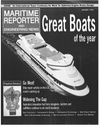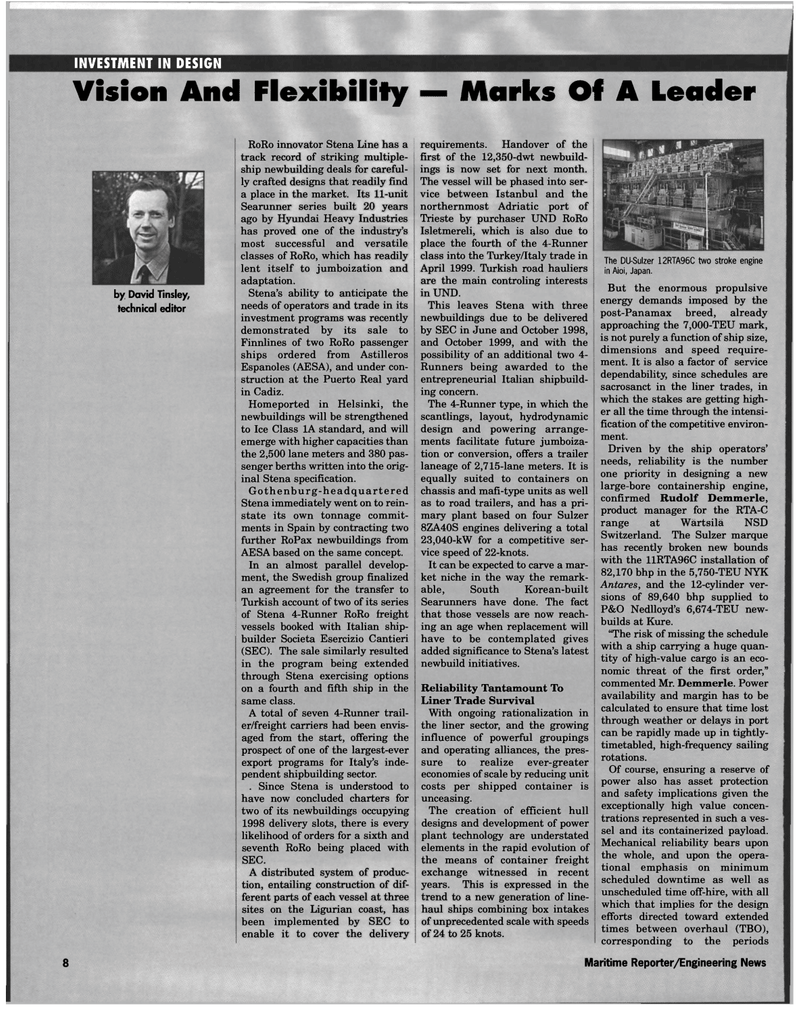
Page 8: of Maritime Reporter Magazine (January 1998)
Read this page in Pdf, Flash or Html5 edition of January 1998 Maritime Reporter Magazine
INVESTMENT IN DESIGN
Vision And Flexibility — Marks Of A Leader by David Tinsley, technical editor
RoRo innovator Stena Line has a track record of striking multiple- ship newbuilding deals for careful- ly crafted designs that readily find a place in the market. Its 11-unit
Searunner series built 20 years ago by Hyundai Heavy Industries has proved one of the industry's most successful and versatile classes of RoRo, which has readily lent itself to jumboization and adaptation.
Stena's ability to anticipate the needs of operators and trade in its investment programs was recently demonstrated by its sale to
Finnlines of two RoRo passenger ships ordered from Astilleros
Espanoles (AESA), and under con- struction at the Puerto Real yard in Cadiz.
Homeported in Helsinki, the newbuildings will be strengthened to Ice Class 1A standard, and will emerge with higher capacities than the 2,500 lane meters and 380 pas- senger berths written into the orig- inal Stena specification.
Gothenburg-headquartered
Stena immediately went on to rein- state its own tonnage commit- ments in Spain by contracting two further RoPax newbuildings from
AESA based on the same concept.
In an almost parallel develop- ment, the Swedish group finalized an agreement for the transfer to
Turkish account of two of its series of Stena 4-Runner RoRo freight vessels booked with Italian ship- builder Societa Esercizio Cantieri (SEC). The sale similarly resulted in the program being extended through Stena exercising options on a fourth and fifth ship in the same class.
A total of seven 4-Runner trail- er/freight carriers had been envis- aged from the start, offering the prospect of one of the largest-ever export programs for Italy's inde- pendent shipbuilding sector. . Since Stena is understood to have now concluded charters for two of its newbuildings occupying 1998 delivery slots, there is every likelihood of orders for a sixth and seventh RoRo being placed with
SEC.
A distributed system of produc- tion, entailing construction of dif- ferent parts of each vessel at three sites on the Ligurian coast, has been implemented by SEC to enable it to cover the delivery requirements. Handover of the first of the 12,350-dwt newbuild- ings is now set for next month.
The vessel will be phased into ser- vice between Istanbul and the northernmost Adriatic port of
Trieste by purchaser UND RoRo
Isletmereli, which is also due to place the fourth of the 4-Runner class into the Turkey/Italy trade in
April 1999. Turkish road hauliers are the main controling interests in UND.
This leaves Stena with three newbuildings due to be delivered by SEC in June and October 1998, and October 1999, and with the possibility of an additional two 4-
Runners being awarded to the entrepreneurial Italian shipbuild- ing concern.
The 4-Runner type, in which the scantlings, layout, hydrodynamic design and powering arrange- ments facilitate future jumboiza- tion or conversion, offers a trailer laneage of 2,715-lane meters. It is equally suited to containers on chassis and mafi-type units as well as to road trailers, and has a pri- mary plant based on four Sulzer 8ZA40S engines delivering a total 23,040-kW for a competitive ser- vice speed of 22-knots.
It can be expected to carve a mar- ket niche in the way the remark- able, South Korean-built
Searunners have done. The fact that those vessels are now reach- ing an age when replacement will have to be contemplated gives added significance to Stena's latest newbuild initiatives.
Reliability Tantamount To
Liner Trade Survival
With ongoing rationalization in the liner sector, and the growing influence of powerful groupings and operating alliances, the pres- sure to realize ever-greater economies of scale by reducing unit costs per shipped container is unceasing.
The creation of efficient hull designs and development of power plant technology are understated elements in the rapid evolution of the means of container freight exchange witnessed in recent years. This is expressed in the trend to a new generation of line- haul ships combining box intakes of unprecedented scale with speeds of 24 to 25 knots.
The DU-Sulzer 12RTA96C two stroke engine in Aioi, Japan.
But the enormous propulsive energy demands imposed by the post-Panamax breed, already approaching the 7,000-TEU mark, is not purely a function of ship size, dimensions and speed require- ment. It is also a factor of service dependability, since schedules are sacrosanct in the liner trades, in which the stakes are getting high- er all the time through the intensi- fication of the competitive environ- ment.
Driven by the ship operators' needs, reliability is the number one priority in designing a new large-bore containership engine, confirmed Rudolf Demmerle, product manager for the RTA-C range at Wartsila NSD
Switzerland. The Sulzer marque has recently broken new bounds with the 11RTA96C installation of 82,170 bhp in the 5,750-TEU NYK
Antares, and the 12-cylinder ver- sions of 89,640 bhp supplied to
P&O Nedlloyd's 6,674-TEU new- builds at Kure. "The risk of missing the schedule with a ship carrying a huge quan- tity of high-value cargo is an eco- nomic threat of the first order," commented Mr. Demmerle. Power availability and margin has to be calculated to ensure that time lost through weather or delays in port can be rapidly made up in tightly- timetabled, high-frequency sailing rotations.
Of course, ensuring a reserve of power also has asset protection and safety implications given the exceptionally high value concen- trations represented in such a ves- sel and its containerized payload.
Mechanical reliability bears upon the whole, and upon the opera- tional emphasis on minimum scheduled downtime as well as unscheduled time off-hire, with all which that implies for the design efforts directed toward extended times between overhaul (TBO), corresponding to the periods 8 Maritime Reporter/Engineering News

 7
7

 9
9
